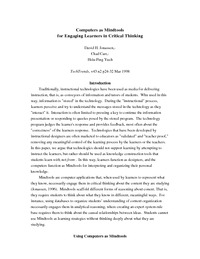Computers as Mindtools for Engaging Learners in Critical ThinkingErstpublikation in: TechTrends, v43 n2 p24-32 Mar 1998
Publikationsdatum:
|
 |
 Diese Seite wurde seit 9 Jahren inhaltlich nicht mehr aktualisiert.
Unter Umständen ist sie nicht mehr aktuell.
Diese Seite wurde seit 9 Jahren inhaltlich nicht mehr aktualisiert.
Unter Umständen ist sie nicht mehr aktuell.
 Zusammenfassungen
Zusammenfassungen
 Traditionally, instructional technologies have been used as media for delivering
instruction, that is, as conveyors of information and tutors of students. Whn used in this
way, information is "stored" in the technology. During the "instructional" process,
learners perceive and try to understand the messages stored in the technology as they
"interact" it. Interaction is often limited to pressing a key to continue the information
presentation or responding to queries posed by the stored program. The technology
program judges the learner's response and provides feedback, most often about the
"correctness" of the learners response. Technologies that have been developed by
instructional designers are often marketed to educators as "validated" and "teacher proof,"
removing any meaningful control of the learning process by the learners or the teachers.
In this paper, we argue that technologies should not support learning by attempting to
instruct the learners, but rather should be used as knowledge construction tools that
students learn with, not from . In this way, learners function as designers, and the
computers function as Mindtools for interpreting and organizing their personal knowledge.
Mindtools are computer applications that, when used by learners to represent what
they know, necessarily engage them in critical thinking about the content they are studying
(Jonassen, 1996). Mindtools scaffold different forms of reasoning about conent. That is,
they require students to think about what they know in different, meaningful ways. For
instance, using databases to organize students’ understanding of content organization
necessarily engages them in analytical reasoning, where creating an expert system rule
base requires them to think about the causal relationships between ideas. Students cannot
use Mindtools as learning strategies without thinking deeply about what they are studying.
Traditionally, instructional technologies have been used as media for delivering
instruction, that is, as conveyors of information and tutors of students. Whn used in this
way, information is "stored" in the technology. During the "instructional" process,
learners perceive and try to understand the messages stored in the technology as they
"interact" it. Interaction is often limited to pressing a key to continue the information
presentation or responding to queries posed by the stored program. The technology
program judges the learner's response and provides feedback, most often about the
"correctness" of the learners response. Technologies that have been developed by
instructional designers are often marketed to educators as "validated" and "teacher proof,"
removing any meaningful control of the learning process by the learners or the teachers.
In this paper, we argue that technologies should not support learning by attempting to
instruct the learners, but rather should be used as knowledge construction tools that
students learn with, not from . In this way, learners function as designers, and the
computers function as Mindtools for interpreting and organizing their personal knowledge.
Mindtools are computer applications that, when used by learners to represent what
they know, necessarily engage them in critical thinking about the content they are studying
(Jonassen, 1996). Mindtools scaffold different forms of reasoning about conent. That is,
they require students to think about what they know in different, meaningful ways. For
instance, using databases to organize students’ understanding of content organization
necessarily engages them in analytical reasoning, where creating an expert system rule
base requires them to think about the causal relationships between ideas. Students cannot
use Mindtools as learning strategies without thinking deeply about what they are studying. Bemerkungen
Bemerkungen
 Leider ist die ursprünglich im Biblionetz erfasste URL eines Volltextes seit mehr als sechs Monaten nicht mehr gültig (Fehlermeldung 404) und wurde deshalb gelöscht. Es ist mir nicht bekannt, ob das Dokument unter einer anderen Adresse noch frei auf dem Internet verfügbar ist.
Leider ist die ursprünglich im Biblionetz erfasste URL eines Volltextes seit mehr als sechs Monaten nicht mehr gültig (Fehlermeldung 404) und wurde deshalb gelöscht. Es ist mir nicht bekannt, ob das Dokument unter einer anderen Adresse noch frei auf dem Internet verfügbar ist. Dieser Text erwähnt ...
Dieser Text erwähnt ...
 Personen KB IB clear | Katherine Beissner , David H. Jonassen , Michael Yacci | |||||||||||||||||||||||||||
 Fragen KB IB clear | Was bringt Computereinsatz in der Schule? | |||||||||||||||||||||||||||
 Begriffe KB IB clear |  Chat Chat chat
, Cognitive Toolscognitive tools
, chat
, Cognitive Toolscognitive tools
,  Datenbank Datenbank database
, Expertensystemexpert system
, HypermediaHypermedia
, Konstruktionismusconstructionism
, microworldmicroworld
, MUDMUD database
, Expertensystemexpert system
, HypermediaHypermedia
, Konstruktionismusconstructionism
, microworldmicroworld
, MUDMUD
| |||||||||||||||||||||||||||
 Bücher |
|
 Zitationsgraph
Zitationsgraph
 Zitationsgraph (Beta-Test mit vis.js)
Zitationsgraph (Beta-Test mit vis.js)
 2 Erwähnungen
2 Erwähnungen 
- PDA macht Schule - M-Learning in der Sekundarstufe (Petra Haller) (2005)

- Foundations of Educational Technology (J. Michael Spector) (2012)

 Volltext dieses Dokuments
Volltext dieses Dokuments
 | Computers as Mindtools for Engaging Learners in Critical Thinking: Artikel als Volltext ( : :  , 127 kByte) , 127 kByte) |
 Anderswo suchen
Anderswo suchen 
 Beat und dieser Text
Beat und dieser Text
Beat war Co-Leiter des ICT-Kompetenzzentrums TOP während er Dieser Text ins Biblionetz aufgenommen hat. Die bisher letzte Bearbeitung erfolgte während seiner Zeit am Institut für Medien und Schule. Beat besitzt kein physisches, aber ein digitales Exemplar. (das er aber aus Urheberrechtsgründen nicht einfach weitergeben darf). Es gibt bisher nur wenige Objekte im Biblionetz, die dieses Werk zitieren.








 Biblionetz-History
Biblionetz-History